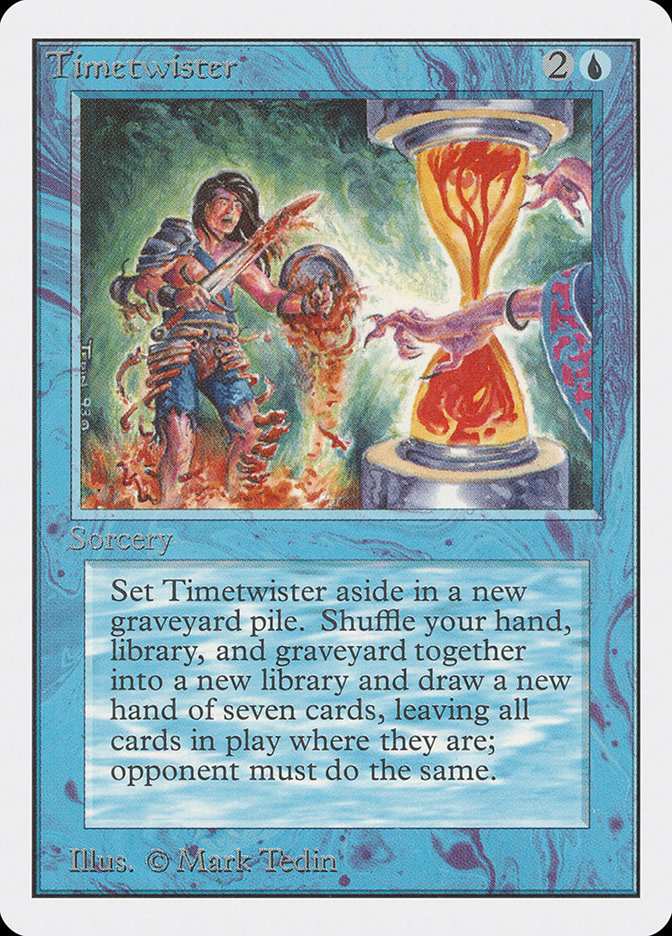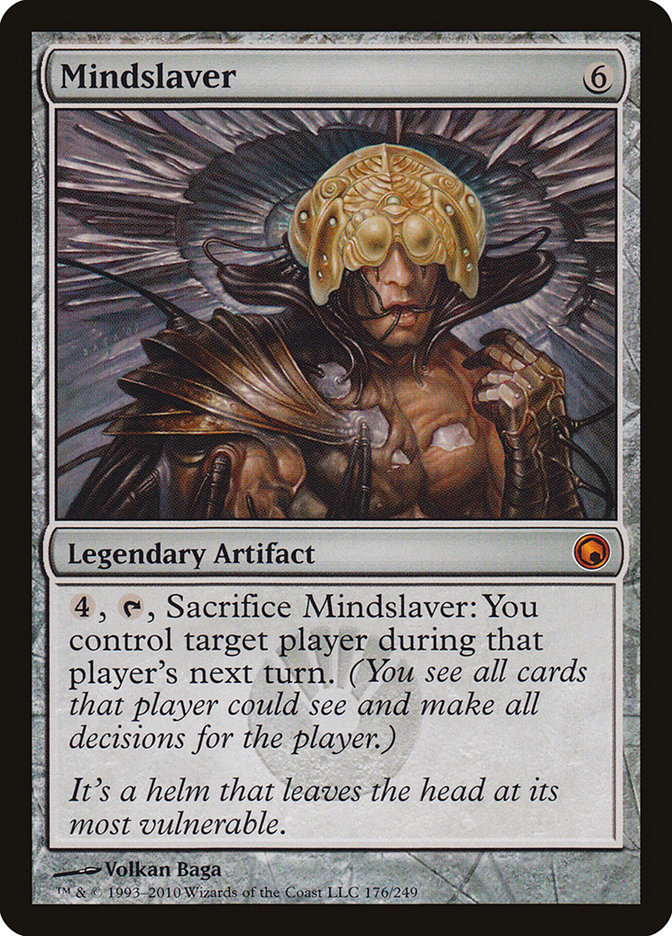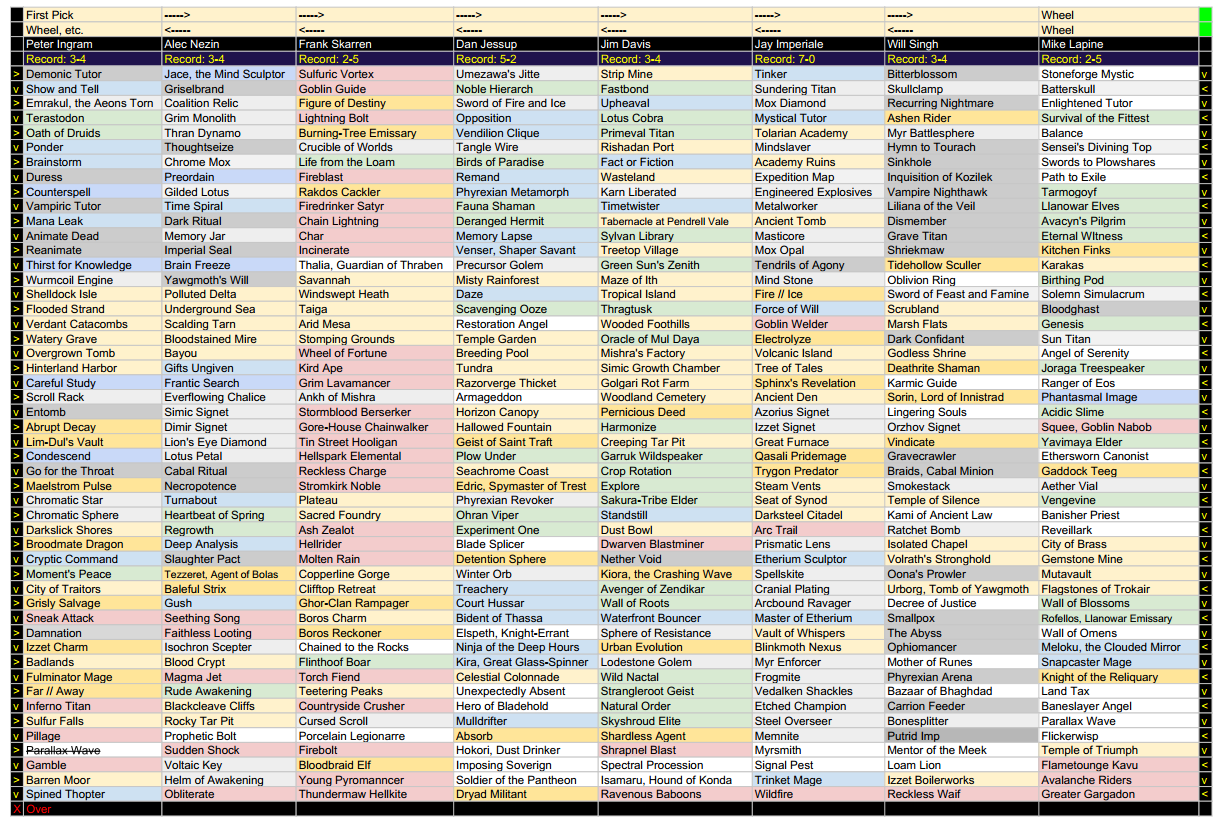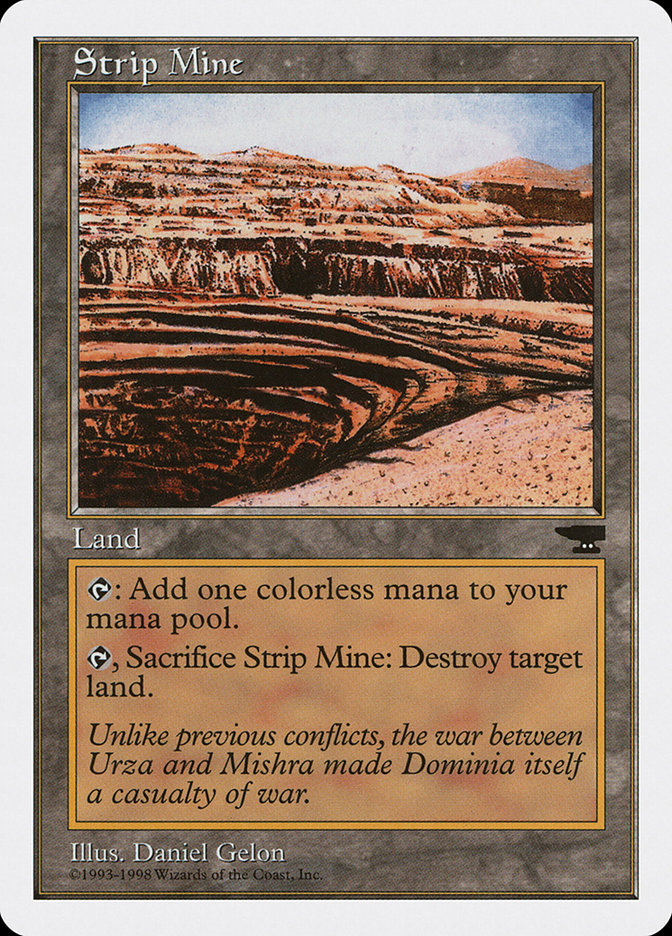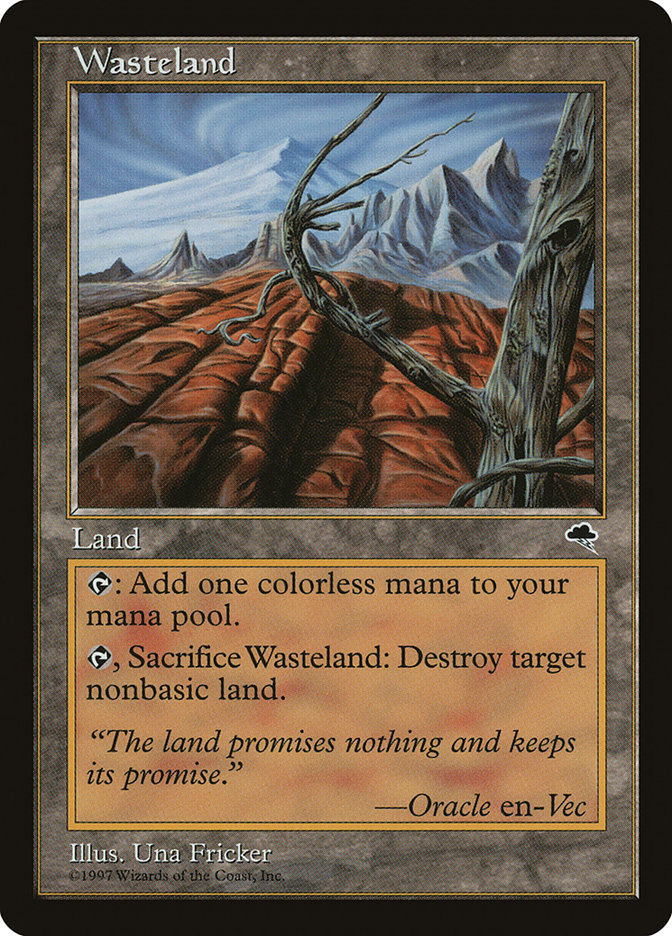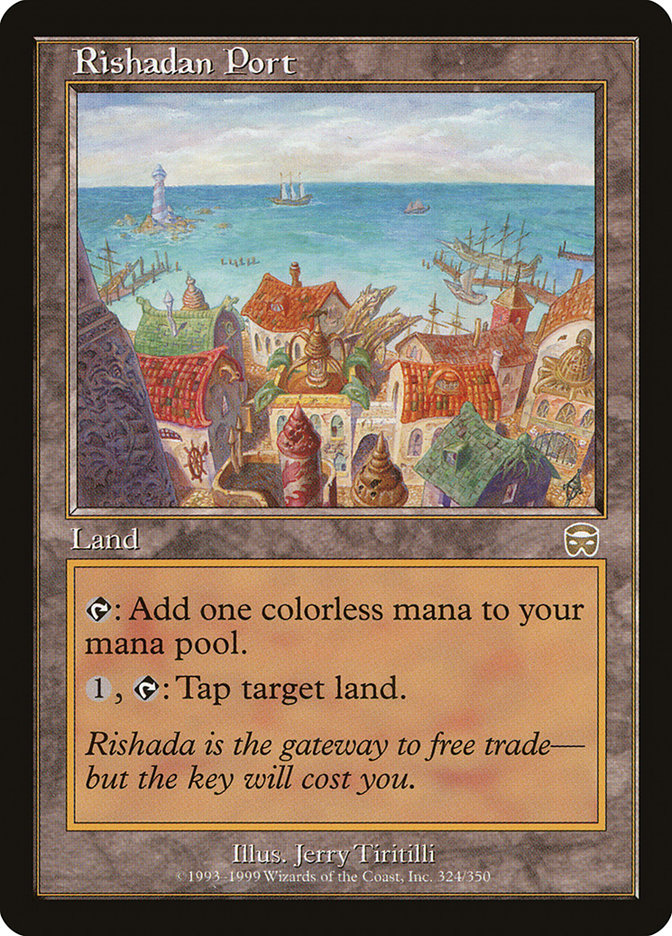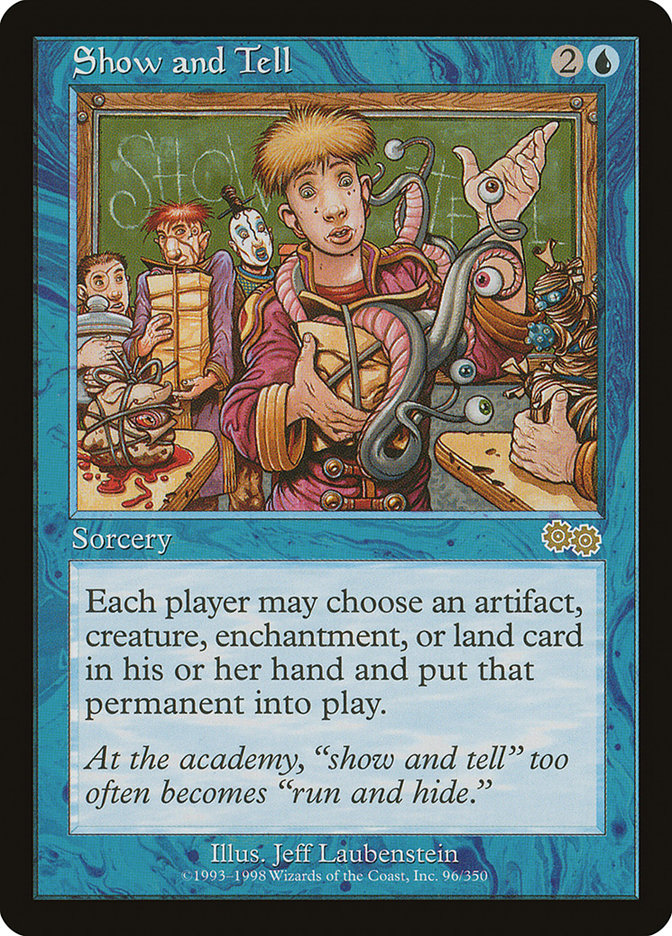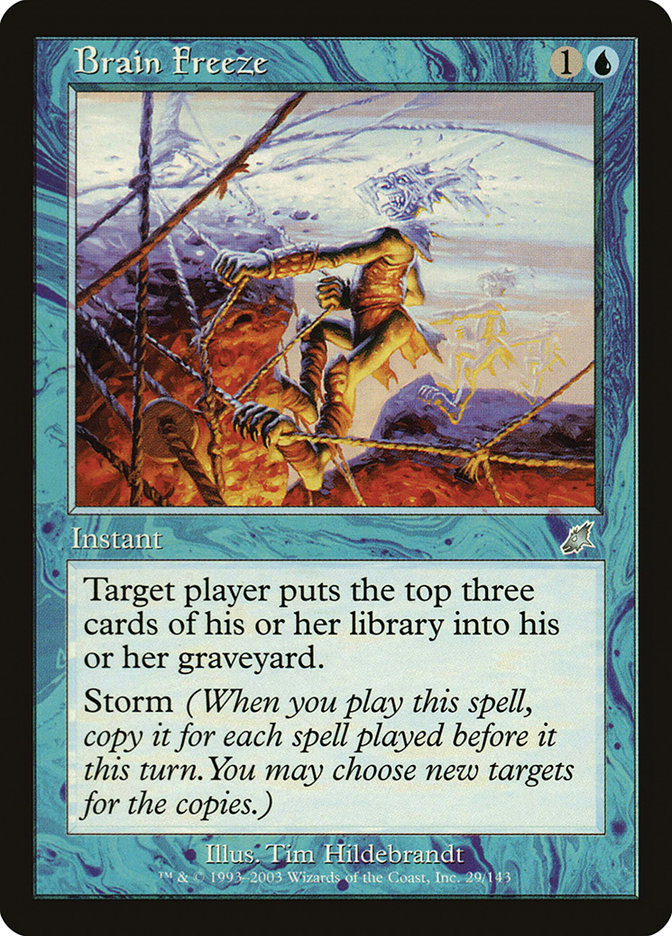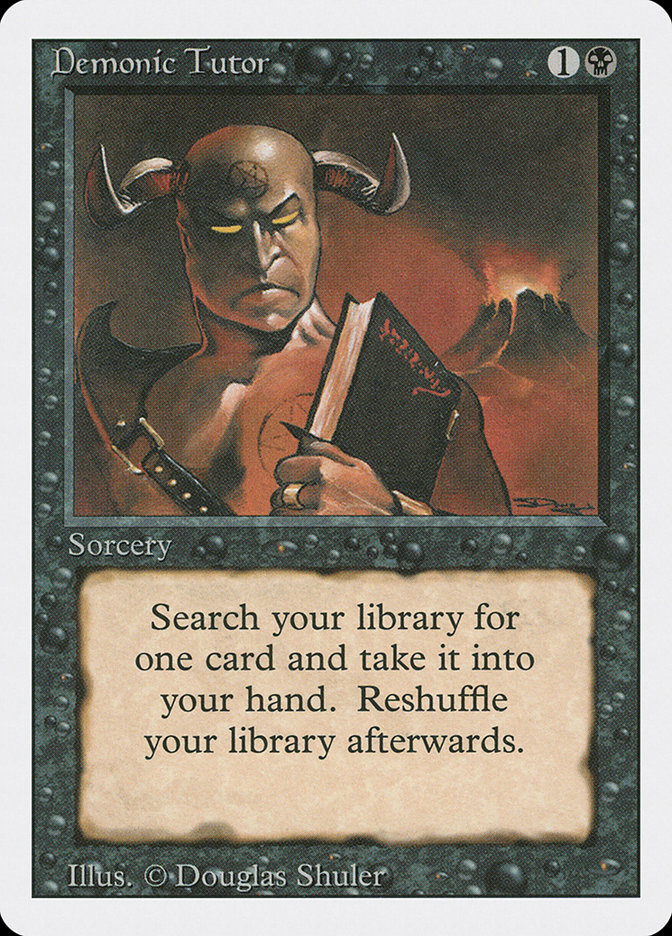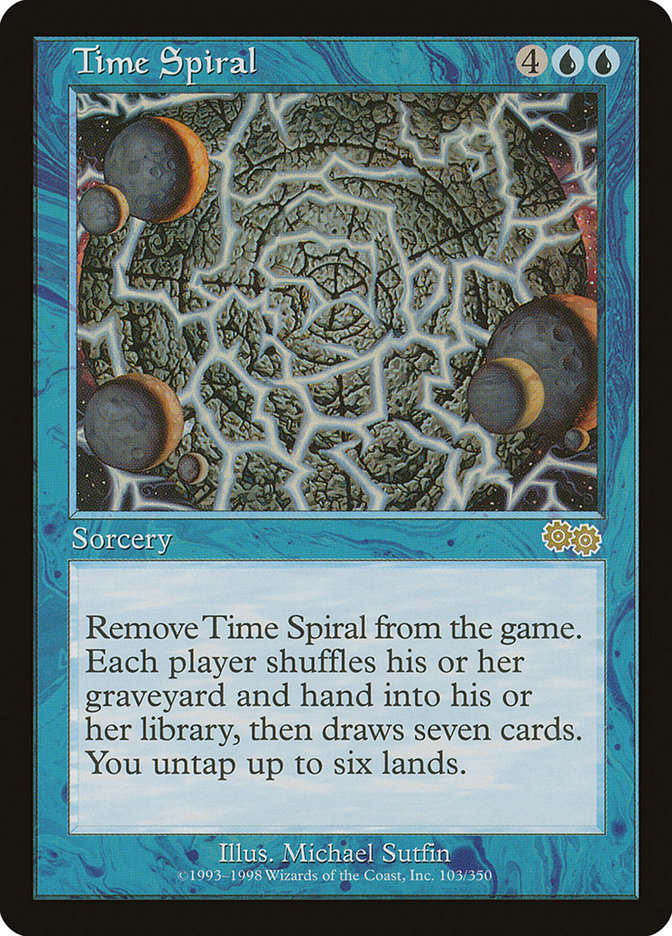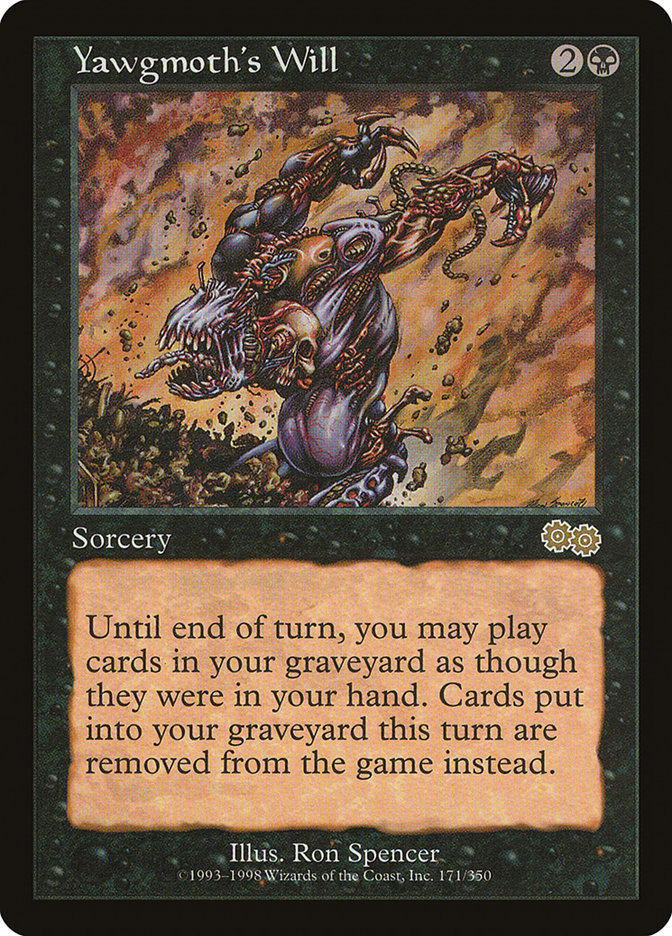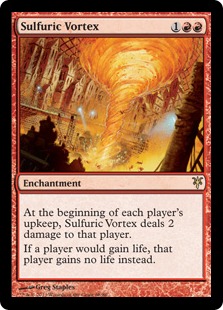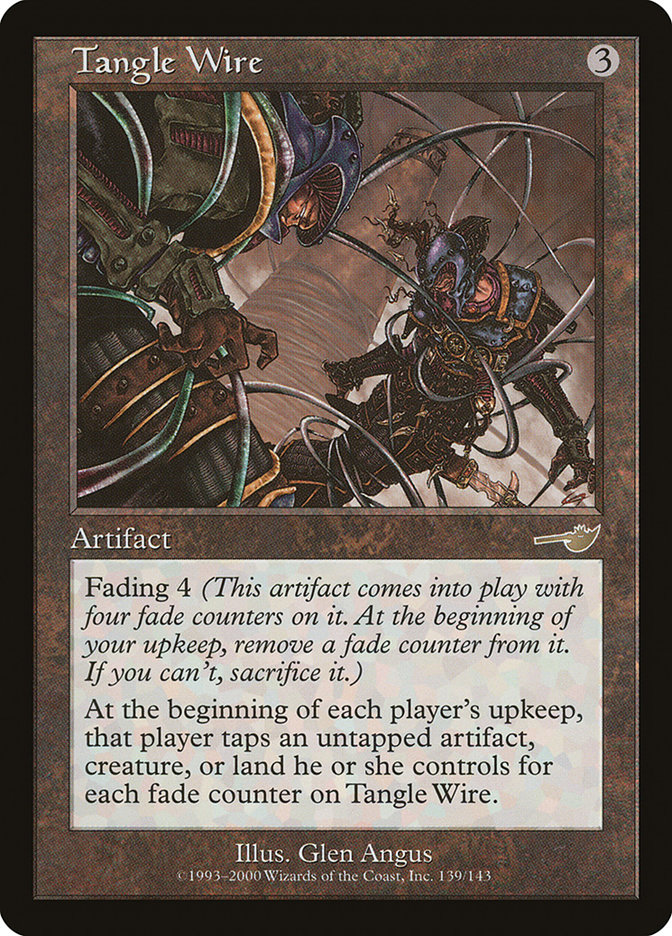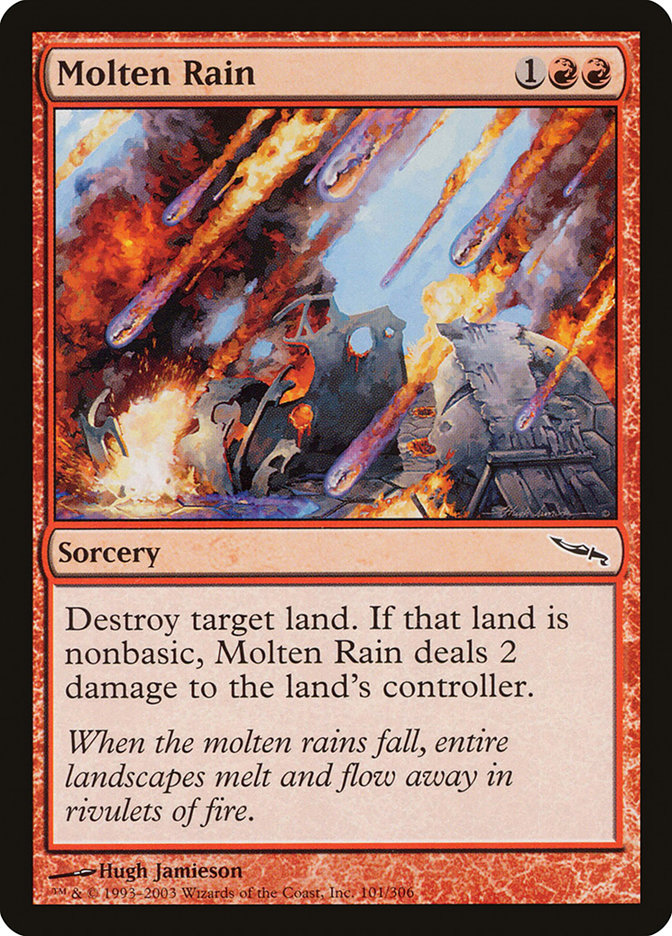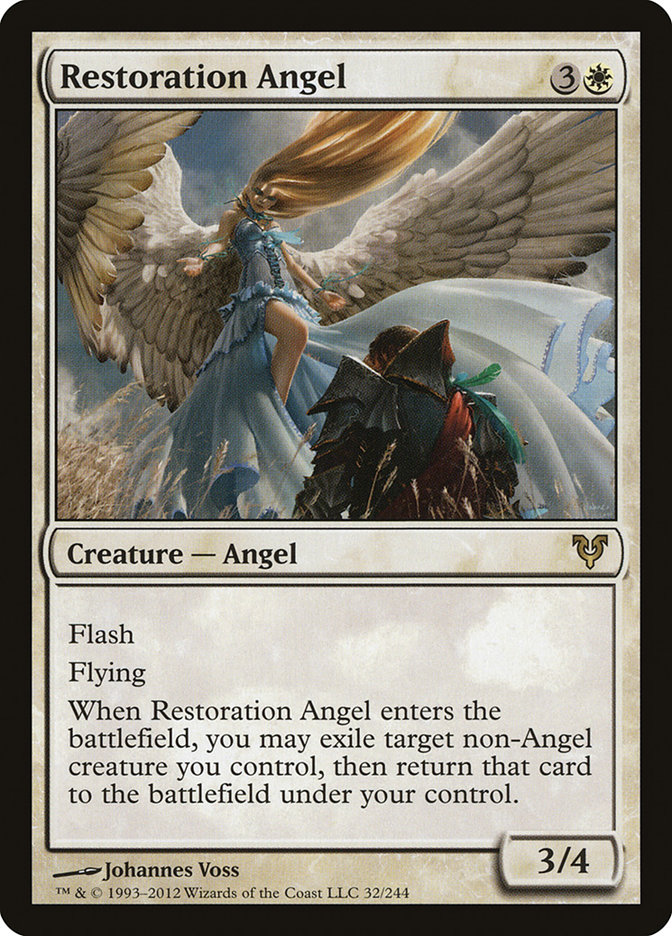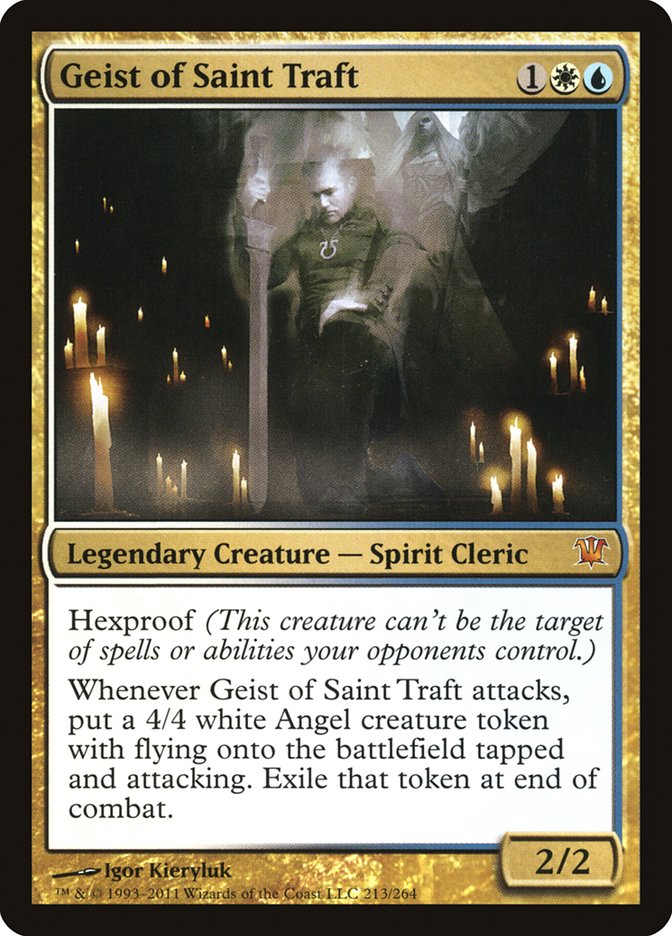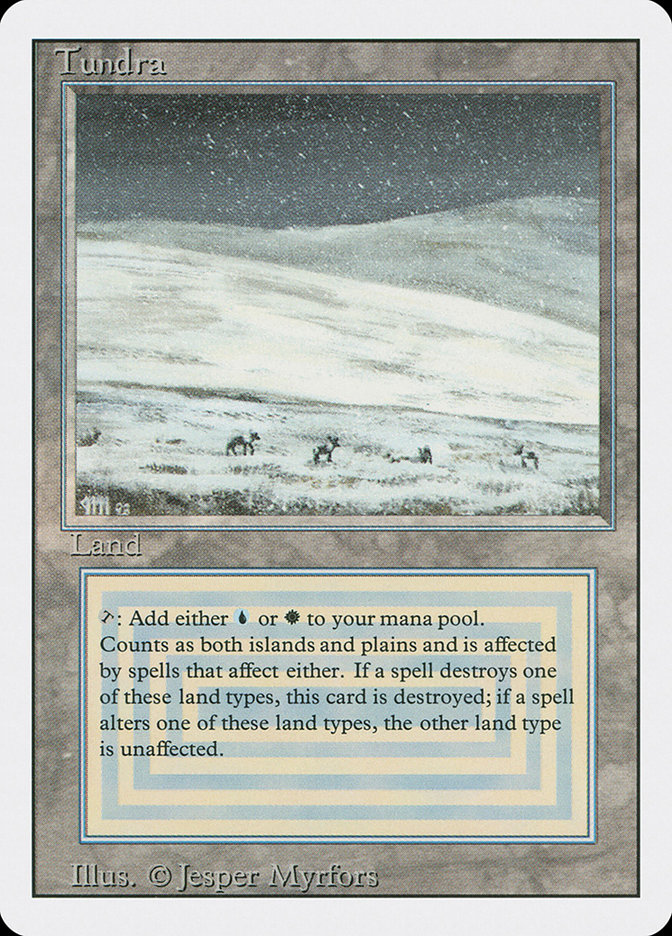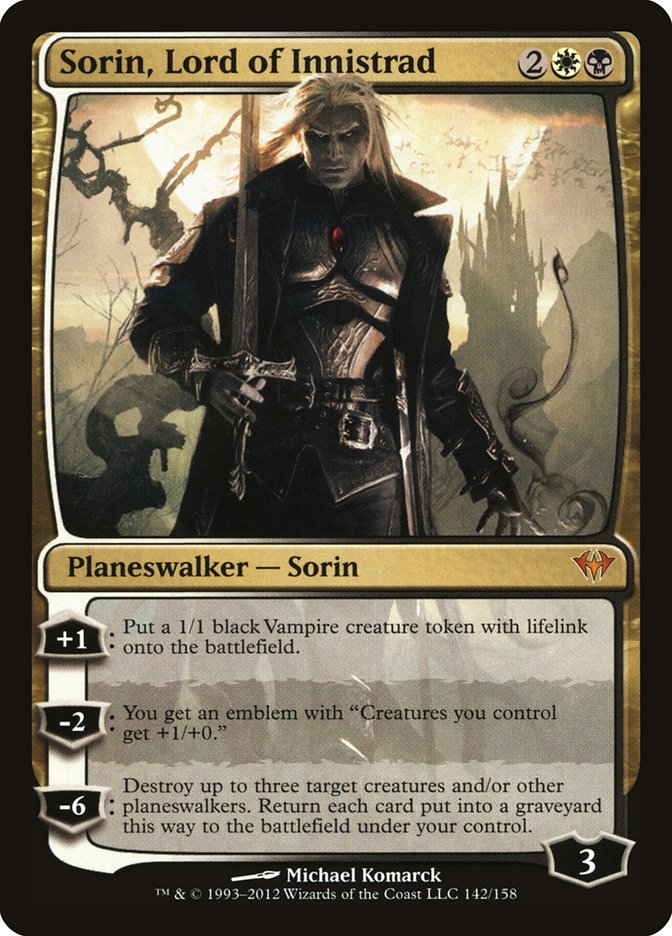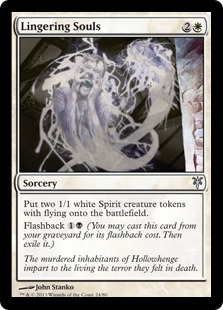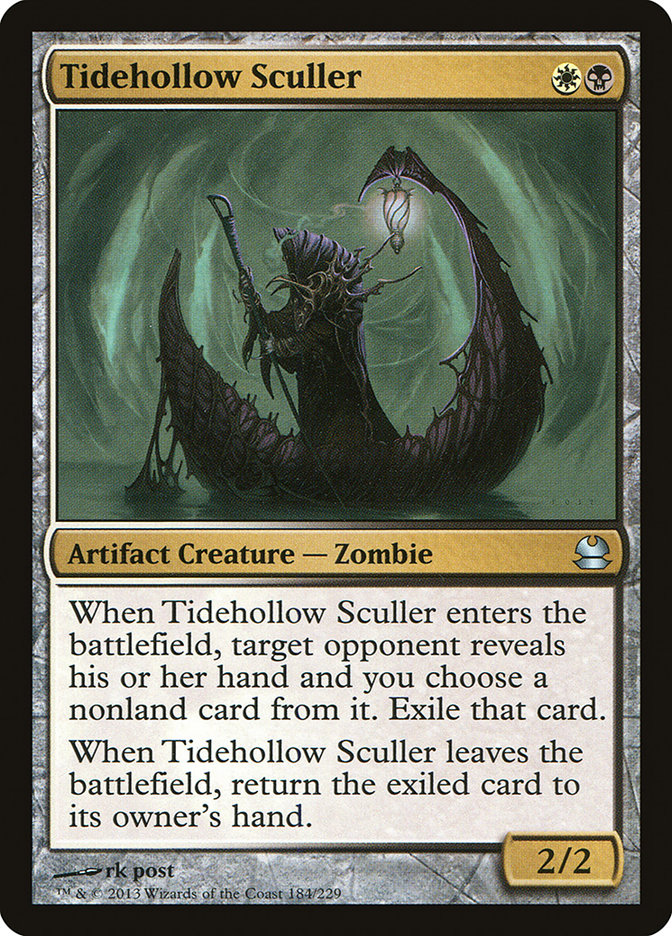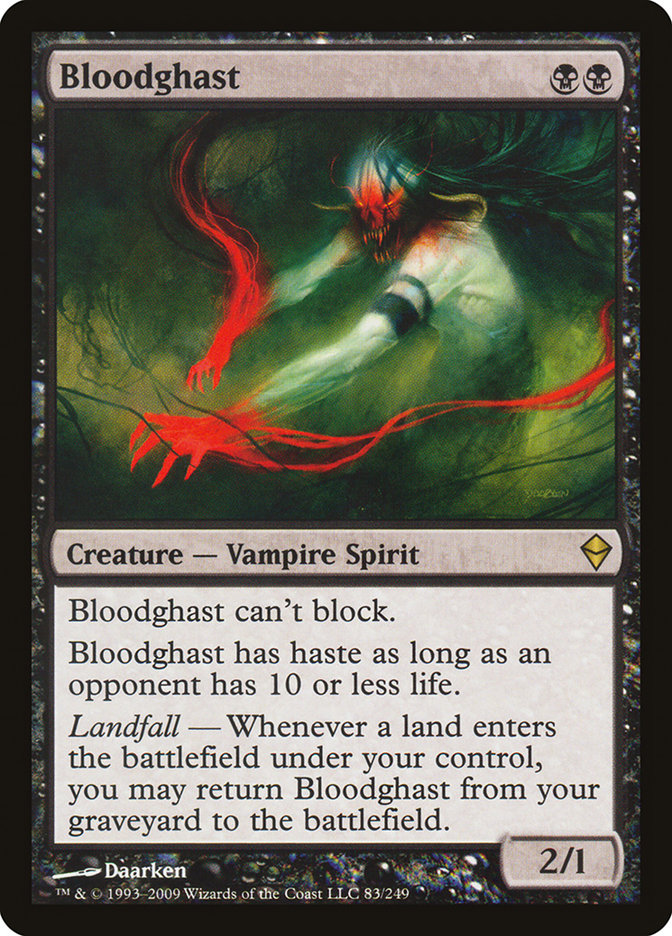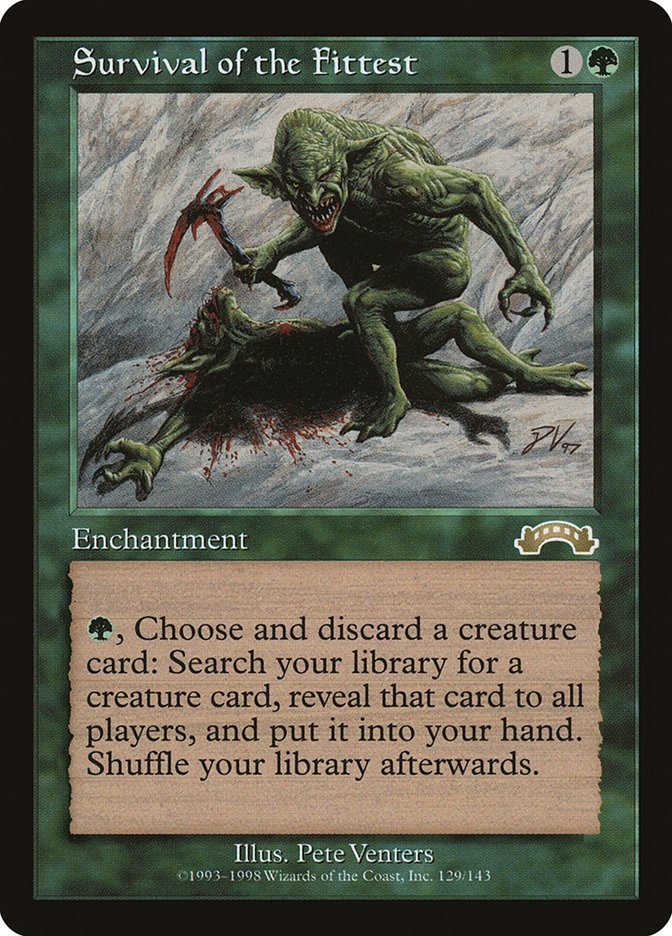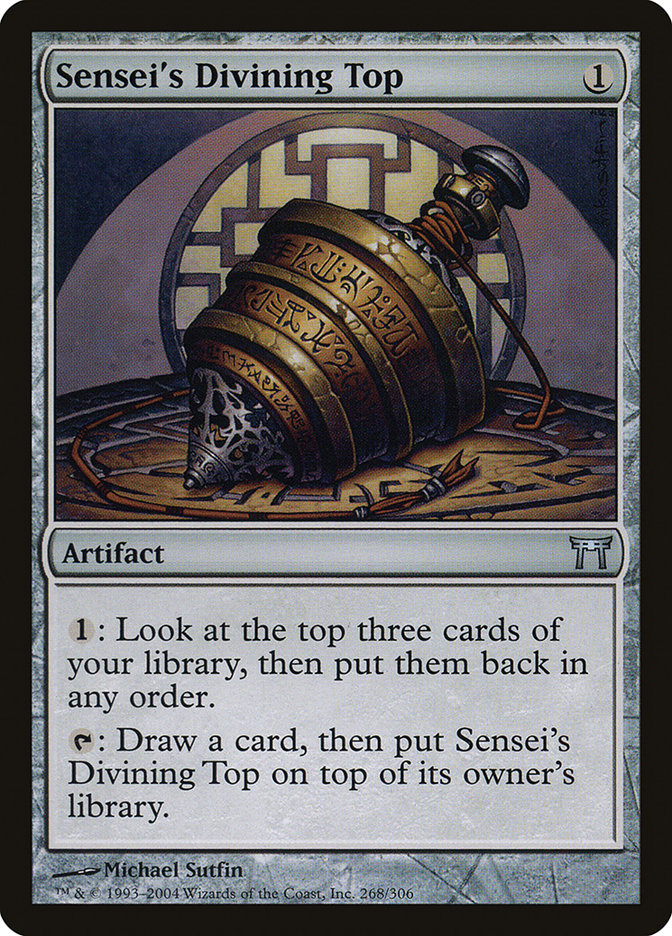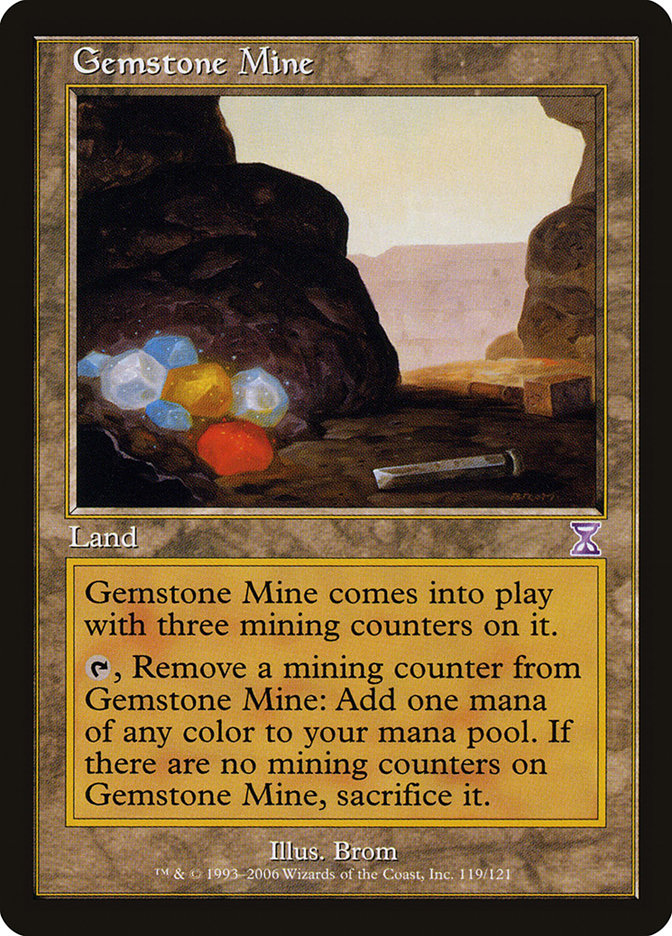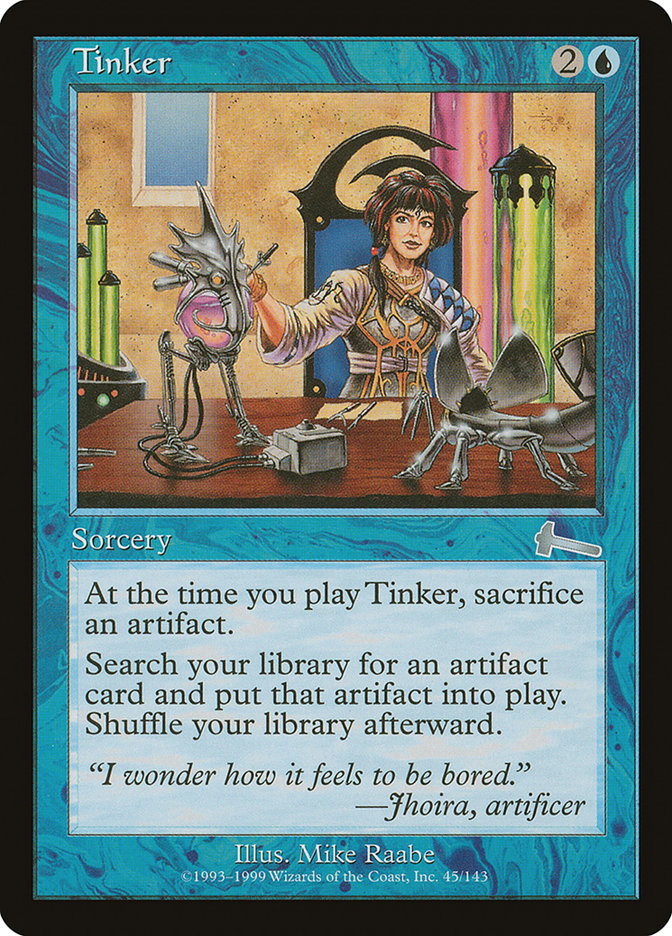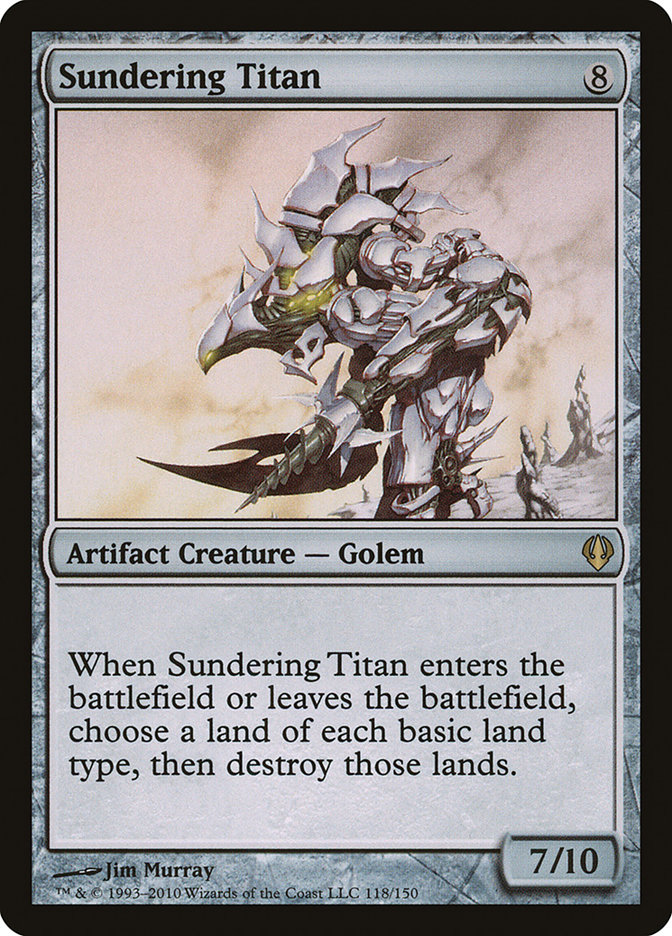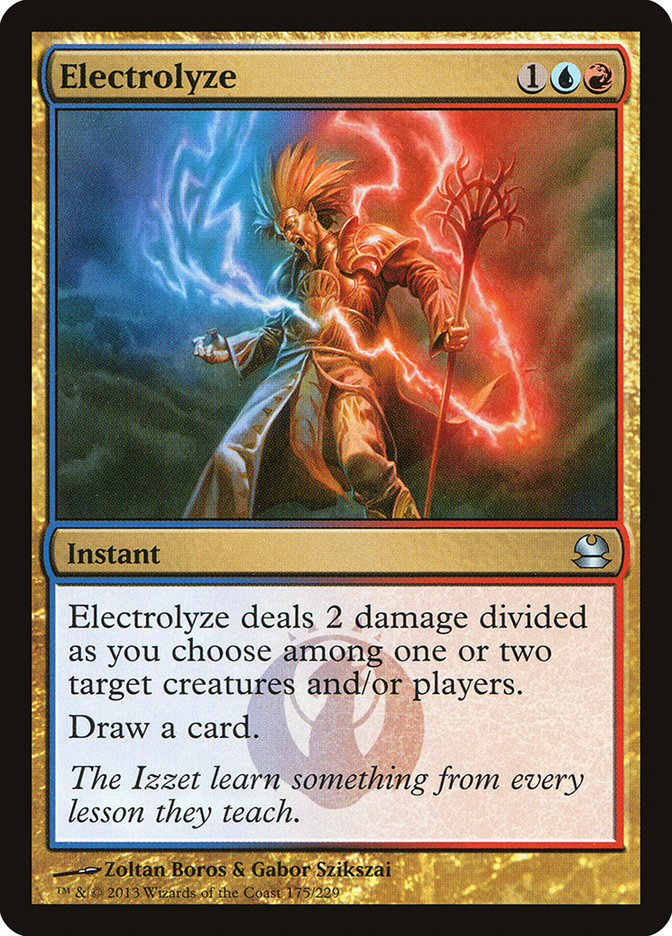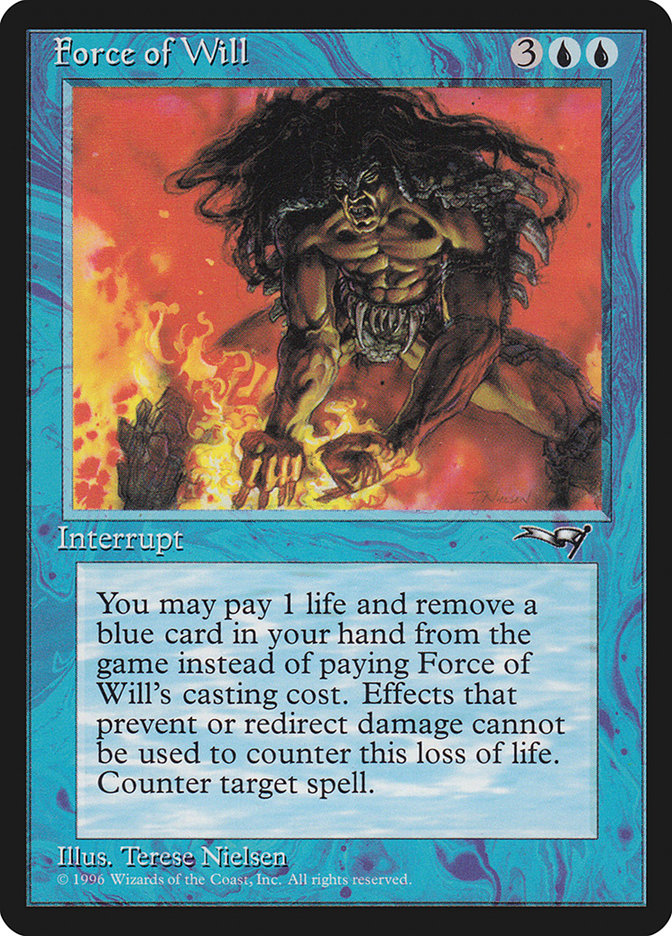Things were looking rather good.
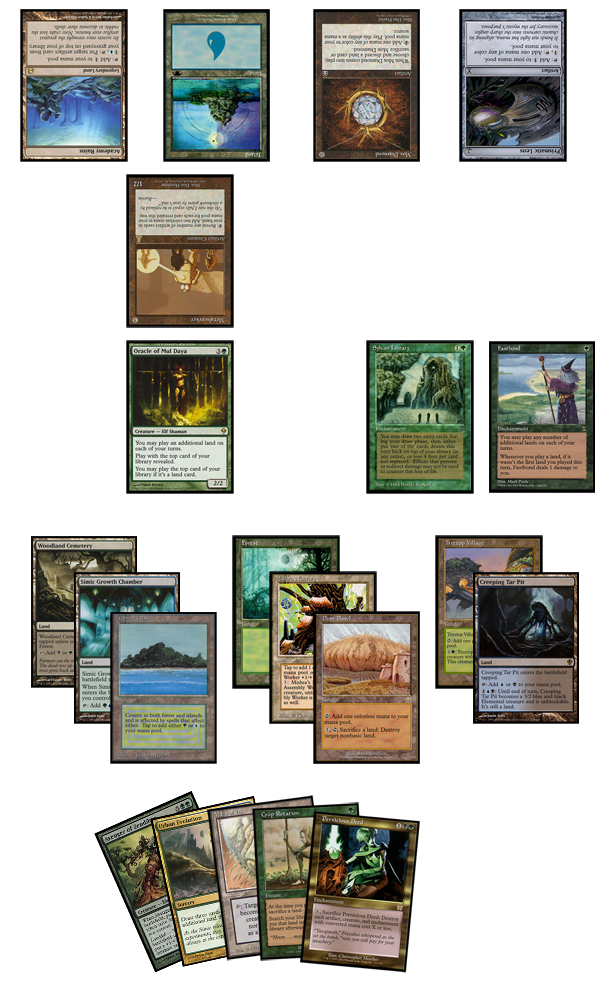
I had opened the game with a Fastbond turn 1 on the play, and after two difficult losses, my deck was finally doing what it was supposed to do. I paid four life and laid out three more of the lands in my hand, including a bounce land, and then cast one of my two remaining cards:
This is a start that a Vintage deck would be thrilled with. My new seven cards were pretty good, and I passed the turn with five lands in play and a full grip— not a bad turn 1. Jay’s turn 2 Metalworker was also a fine start, but after durdling for a turn with Oracle of Mul Daya, I was ready to put this game away on turn 3 with a Pernicious Deed for most of Jay’s board. I had already amassed a large amount of lands, Oracle of Mul Daya, and Sylvan Library and had a hand full of gas, and the only way I was really going to lose this one was to some busted Metalworker activations.
I played the Deed, and Jay tapped his Metalworker to hard cast Force of Will and put a stop to it. Still very confident with my situation, I built my board some more and passed the turn. Jay untapped, made six mana with Metalworker, and won the game:
After Mindslavering me, he took my turn; he cast an Upheaval, played a Forest and a Fastbond, and then repeatedly played my Simic Growth Chamber by paying one life to Fastbond and then returning it with its bounce trigger til I was dead.
Isn’t Cube awesome?
The Rotisserie (Chicken) Draft
Three weeks ago seven of my friends and I embarked on a very interesting way to draft known as rotisserie draft. If anyone has any idea why it’s called rotisserie draft beyond a love of delicious chicken, please feel free to enlighten me. You can use any large card pool to do it, and everyone drafts the entire card pool at once in a snake pattern similar to a fantasy football draft.

For this rotisserie draft we used my Cube, and after some deliberation we decided that the best way to logistically do the draft was on a shared online spreadsheet where we could all make our picks at our leisure over a long set period of time. While it is definitely possible to do a rotisserie draft in real life, it requires a large amount of time and table space, and this seemed like a much better solution. It was also very enjoyable to watch the draft pan out over the three weeks and to be able to plan out the draft as it went along.
It also has the nice bonus of being recorded for posterity’s sake.
The Draft
Here is the draft in its entirety.
Having such a vast and powerful card pool at your disposal makes a draft like this extremely interesting. Unlike in a regular draft where you are merely hoping to get that Show and Tell to go with your Griselbrand, in a rotisserie draft the world is at your fingertips . . . as long as it doesn’t end up in someone else’s grubby hands first. Everyone is also able to see everyone else’s picks, so you can clearly cooperate or not cooperate as you see fit.
The Decks
Creatures (7)
- 1 Sakura-Tribe Elder
- 1 Wall of Roots
- 1 Lotus Cobra
- 1 Oracle of Mul Daya
- 1 Avenger of Zendikar
- 1 Primeval Titan
- 1 Thragtusk
Planeswalkers (3)
Lands (19)
Spells (11)

Going into the draft, I looked over the Cube and put together a few decks I thought I might want to draft. The two decks I settled on were a graveyard-based G/B deck with Survival of the Fittest, Bloodghast, Skullclamp, resource denial, and recursion and a land-based deck with Fastbond, mana denial, card draw, and the most powerful lands the Cube has to offer. I decided to go with Lands since it seemed like it would have the least amount of highly contested cards. Cooperation is a very important part of drafting, and I was looking to avoid needing cards that other people would want at all costs.
I opened my draft with Strip Mine, figuring that not only would it be a centerpiece of my deck but it would also allow me to backdoor into an aggressive strategy if I was cut off. While not exactly a card that signifies a particular archetype, I felt it was actually a cornerstone of the deck I wanted to draft. With a second pick Fastbond, we were off to the races. I had mostly constructed the deck before the draft and was looking to get as many of the pieces as I could. As I knew many of the cards I wanted (like Oracle of Mul Daya and Crop Rotation) would go later in the draft, I was able to focus my early picks on getting the nonbasic lands and card draw I needed.
Aggressive picking got me the trifecta that I really wanted but also lost me Crucible of Worlds and Life from the Loam to a cut. All in all, I got most of the cards I wanted aside from the graveyard recursion stuff and was rather happy with my deck. The only other two cards I really regret missing out on are Sensei’s Divining Top and Mox Diamond.
The only major issue I had with my deck was how inconsistent it felt. The games I drew Fastbond felt like I was playing the most broken deck ever, as they would quickly spiral into a flurry of land drops, card draw spells, and brutal mana denial. However, the games without Fastbond were much less smooth. I had figured with four extra turn 2 accelerants in Wall of Roots, Lotus Cobra, Sakura Tribe-Elder, and Explore I would have a very good chance of having either one or Fastbond almost every game. This was not the case, and I think in many of the games I was simply not mulliganing aggressively enough to them.
Some cards also underperformed; once I lost my shot of having graveyard recursion, I decided I needed to move in a more mana ramp direction, but both Kiora, the Crashing Wave and Karn Liberated underperformed. They simply just didn’t do enough when the decks were so good and focused.
I had not considered how tight the decks were really going to be. With access to every card, building a busted combo deck was much easier than in a normal draft, and my deck was meant to grind out advantages, not deal with Emrakul the Aeons Torn on turn 3. My losses came to the two combo decks in the draft, Jay’s Mindslaver and Will’s combination of Smallpox, Vindicate, and Sinkhole.
I think for the most part I played a large part in my losses as well, as I simply wasn’t mulliganing my weak hands aggressively enough. Any deck with busted cards like Fastbond and obscene amounts of card draw is going to mulligan very well. I also spent a lot of picks building my sideboard for the combo decks (Waterfront Bouncer for Pete and Sphere of Resistance, Nether Void, and Lodestone Golem for Alec along with a few more aggressive creatures) only to again not mulligan aggressively enough for them.
Creatures (4)
Lands (16)
Spells (20)

Speaking of Emrakul on turn 3, we come to Pete’s deck. Pete had the unenviable position of being first in the draft. When faced with an entire card pool, no idea what everyone is going to draft, and knowing you are not going to get another pick for fourteen picks, it can be very hard to decide where you want to begin.
While I initially disliked Pete’s first pick of Demonic Tutor a lot, once he hit his wheel and was able to nab both Show and Tell and Emrakul in one swoop, it looked a lot better. Pete had selected a powerful and open-ended card that would still let him react to the rest of the draft, and in hindsight I think it was a very reasonable pick.
Somewhat surprisingly, Pete only went 3-4 with his deck. On paper his deck seemed absurdly powerful, with Vintage/Legacy staples Oath of Druids / Show and Tell, multiple tutors, and a powerful reanimation backup plan, but I guess that’s why we play the games. I do think he focused a bit too much on the reactive cards like Counterspell, Mana Leak, and Go for the Throat, and it was certainly unfortunate that Alec nabbed his Griselbrand.
Creatures (1)
Planeswalkers (1)
Lands (11)
Spells (27)
- 1 Heartbeat of Spring
- 1 Cabal Ritual
- 1 Grim Monolith
- 1 Yawgmoth's Will
- 1 Necropotence
- 1 Regrowth
- 1 Dark Ritual
- 1 Imperial Seal
- 1 Gifts Ungiven
- 1 Brain Freeze
- 1 Memory Jar
- 1 Frantic Search
- 1 Turnabout
- 1 Gilded Lotus
- 1 Time Spiral
- 1 Thran Dynamo
- 1 Deep Analysis
- 1 Lotus Petal
- 1 Lion's Eye Diamond
- 1 Chrome Mox
- 1 Dimir Signet
- 1 Simic Signet
- 1 Coalition Relic
- 1 Slaughter Pact
- 1 Thoughtseize
- 1 Everflowing Chalice
- 1 Preordain

Like Pete, Alec went for a very open-ended and powerful first overall pick with Jace, the Mind Sculptor. Jace is so good in so many decks that Alec would be able to read the rest of the draft and then find his own niche as he saw fit.
And find a niche he did.
Alec kept his draft pretty open in the early going, picking up some artifact mana acceleration and a couple open-ended cards, and then on pick 10 he moved in:
Alec moved in on Storm, and despite Jay cutting the Tendrils of Agony with his fourteenth pick, nobody else stepped up and took away Brain Freeze. Alec was able to pick up many of the most broken cards in the Cube, with enough tutors and draw 7s to make even a Vintage deck jealous. Alec was also able to pick up Heartbeat of Spring and Regrowth for a powerful green splash, giving himself likely the most difficult to play deck in the draft.
One glaring weakness however was how single minded his deck was. He had no reasonable way to defeat the triggered ability of Pete’s Emrakul and was going to be in big trouble if someone had a way to deal with his Brain Freeze.
While he only went 3-4 with the deck, Alec had some of the most interesting games of the draft.
Creatures (17)
- 1 Kird Ape
- 1 Grim Lavamancer
- 1 Tin Street Hooligan
- 1 Countryside Crusher
- 1 Figure of Destiny
- 1 Hellspark Elemental
- 1 Goblin Guide
- 1 Porcelain Legionnaire
- 1 Stormblood Berserker
- 1 Stromkirk Noble
- 1 Flinthoof Boar
- 1 Ash Zealot
- 1 Gore-House Chainwalker
- 1 Rakdos Cackler
- 1 Burning-Tree Emissary
- 1 Ghor-Clan Rampager
- 1 Firedrinker Satyr
Lands (15)
Spells (8)

While Pete and Alec kept their first picks very open, Frank loudly announced his intentions with his first pick:
This ended up being very successful, as everyone pretty much completely avoided red cards for a major portion of the draft. One of the big things about these types of open-faced drafts is cooperation. By making such a polarizing first pick, Frank staked his claim, and it paid off.
Knowing he was going to be the only aggressive red drafter afforded Frank the opportunity to make cuts when he needed to (although why he didn’t cut the Brain Freeze I’m not sure) and pick up the lands he wanted early for his two minor splashes. Another factor in a draft like this is the multicolor section of the Cube will often be untouched in certain color combinations, and Frank was able to get a number of powerful splash cards late in the draft.
However, Frank was unhappy with both his record of 2-5 and what he perceived as lack of support for the mono-red deck in the Cube. I think one of the key errors that Frank made in his draft, especially given the circumstances of their being multiple combo decks, was really neglecting any sort of disruption.
While Frank had all the one-drops and burn spells he could really want, he was not able to put his opponents off balance enough to stop them from doing whatever they wanted to be doing. One of the key factors in aggressive decks in Cube is that they need to be able to apply pressure and then take advantage of it. There is a reason that Wasteland is one of the best aggressive cards in Legacy and why all the old Red Deck Wins decks started with four Wastelands and four Rishadan Ports. While Frank did pick up a Molten Rain and Thalia, Guardian of Thraben, he chose to have them in his sideboard rather than play them.
Just like in other high-powered formats like Legacy, straight beatdown is often not enough; without the disruption to put your opponents off balance, they will often be able to stabilize and take the game back.
Creatures (12)
- 1 Venser, Shaper Savant
- 1 Mulldrifter
- 1 Vendilion Clique
- 1 Precursor Golem
- 1 Hero of Bladehold
- 1 Phyrexian Revoker
- 1 Phyrexian Metamorph
- 1 Blade Splicer
- 1 Geist of Saint Traft
- 1 Restoration Angel
- 1 Imposing Sovereign
- 1 Soldier of the Pantheon
Planeswalkers (1)
Lands (17)
Spells (10)
- 1 Umezawa's Jitte
- 1 Armageddon
- 1 Memory Lapse
- 1 Daze
- 1 Sword of Fire and Ice
- 1 Opposition
- 1 Tangle Wire
- 1 Remand
- 1 Detention Sphere
- 1 Unexpectedly Absent
Sideboard
- 1 Ninja of the Deep Hours
- 1 Kira, Great Glass-Spinner
- 1 Hokori, Dust Drinker
- 1 Treachery
- 1 Plow Under
- 1 Birds of Paradise
- 1 Winter Orb
- 1 Deranged Hermit
- 1 Absorb
- 1 Temple Garden
- 1 Breeding Pool
- 1 Court Hussar
- 1 Ohran Viper
- 1 Horizon Canopy
- 1 Noble Hierarch
- 1 Fauna Shaman
- 1 Razorverge Thicket
- 1 Edric, Spymaster of Trest
- 1 Scavenging Ooze
- 1 Dryad Militant
- 1 Experiment One
- 1 Bident of Thassa

Dan’s draft certainly was an interesting one. I didn’t love his first pick; because there are a number of combo strategies in the Cube, Umezawa’s Jitte is not as powerful against everyone as it would be in a more midrangey Cube. However, about fifteen picks in his deck was looking very good. Opposition is one of the most powerful and difficult cards to use in the Cube, and backing it up with green mana acceleration, some light control elements, a fast creature base, and powerful Equipment was looking really good.
Around pick 20 Dan started moving into a light splash of white to take advantage of the fact that it was going almost completely undrafted. The biggest twist would end up being the final result, as he would completely abandon green altogether and end up being just straight W/U. While results don’t lie and his 5-2 record was good for second place in the draft, I think he definitely gave up some power by leaving the green on the bench. His mana seemed good enough to support it, and Noble Hierarch and Birds of Paradise were simply so good in his deck that I think it would have been worth it.
Regardless, Dan’s draft is an excellent look at moving in on an undrafted color and reaping great rewards while everyone else fights over their picks.
Creatures (8)
- 1 Braids, Cabal Minion
- 1 Dark Confidant
- 1 Shriekmaw
- 1 Tidehollow Sculler
- 1 Vampire Nighthawk
- 1 Mentor of the Meek
- 1 Ashen Rider
- 1 Ophiomancer
Planeswalkers (2)
Lands (17)
Spells (13)
- 1 Hymn to Tourach
- 1 Recurring Nightmare
- 1 The Abyss
- 1 Sinkhole
- 1 Skullclamp
- 1 Vindicate
- 1 Smallpox
- 1 Oblivion Ring
- 1 Bitterblossom
- 1 Inquisition of Kozilek
- 1 Sword of Feast and Famine
- 1 Dismember
- 1 Lingering Souls
Sideboard

Like Frank, Will dived right into his color, starting his draft with the nice combo of Bitterblossom and Skullclamp and then adding the powerful Recurring Nightmare and some fatties. While Will had the monopoly on black cards for the early portion of the draft, he was losing out on most of the targeted discard and tutors to Pete and Alec. Recognizing both this and the fact that white was rather underdrafted, he moved into a white splash:
These cards fit his deck wonderfully and gave him an excellent token subtheme that worked great with his sacrifice effects; Braids, Cabal Minion; and Skullclamp. Will was also able to pick up a late Dark Confident that just didn’t really fit in anyone’s deck along with every possible B/W dual land.
The only card that Will was really missing was Bloodghast, which would have been fantastic with his Skullclamp and Braids and likely would have gotten Smokestack into his deck.
Despite his 3-4 record, Will probably had the smoothest draft of the entire group, and I’m a bit surprised he didn’t do better.
Creatures (16)
- 1 Llanowar Elves
- 1 Solemn Simulacrum
- 1 Genesis
- 1 Eternal Witness
- 1 Greater Gargadon
- 1 Tarmogoyf
- 1 Reveillark
- 1 Kitchen Finks
- 1 Knight of the Reliquary
- 1 Acidic Slime
- 1 Stoneforge Mystic
- 1 Joraga Treespeaker
- 1 Vengevine
- 1 Sun Titan
- 1 Phantasmal Image
- 1 Avacyn's Pilgrim
Lands (15)
Spells (9)
- 1 Sensei's Divining Top
- 1 Enlightened Tutor
- 1 Swords to Plowshares
- 1 Balance
- 1 Aether Vial
- 1 Survival of the Fittest
- 1 Path to Exile
- 1 Birthing Pod
- 1 Batterskull
Sideboard
- 1 Rofellos, Llanowar Emissary
- 1 Wall of Blossoms
- 1 Land Tax
- 1 Meloku the Clouded Mirror
- 1 Avalanche Riders
- 1 Yavimaya Elder
- 1 Squee, Goblin Nabob
- 1 Flametongue Kavu
- 1 Parallax Wave
- 1 Gaddock Teeg
- 1 Flickerwisp
- 1 Ethersworn Canonist
- 1 Ranger of Eos
- 1 Baneslayer Angel
- 1 Bloodghast
- 1 Wall of Omens
- 1 Snapcaster Mage
- 1 Angel of Serenity
- 1 Banisher Priest

With the eighth and ninth picks of the draft, Mike would have the first wheel, and he scooped up everyone’s favorite pairing of Stoneforge Mystic and Batterskull. Having one of the wheels seems like a nice advantage in a draft like this, as you can take a pair of naturally comboing cards with no fear of losing out on one of them as you wait for your next pick. However, I don’t think that Mike needed to take Batterskull here right away; while I might have waited too long to pick up my Crucible of Worlds and ended up losing it, it’s not likely that anyone else would have wanted Batterskull without Stoneforge Mystic. Mike could have taken a more abstractly powerful Equipment like Sword of Fire and Ice and picked up the Batterskull later.
With his next few picks Mike continued to take powerful and fairly open-ended cards, before settling into a Birthing Pod / Survival of the Fittest deck filled with enters the battlefield creatures and recursion effects. He was also able to pick up some excellent sideboard cards like Gaddock Teeg, Ethersworn Canonist, Wall of Blossoms, and Wall of Omens.
Interestingly enough, Mike simply stayed out of the massive land grab that started around pick 15, and he watched as every G/W dual land was drafted away from him. This left him with only Gemstone Mine and City of Brass as mana fixers, and while they worked well with some of his splash creatures, it left him with a shaky mana base. I was also surprised he did not play Squee, Goblin Nabob to go with his Survival of the Fittest.
Mike’s draft seemed to lack focus, and that plus the inconsistency of his mana base likely led to his 2-5 record.
Creatures (9)
- 1 Metalworker
- 1 Sundering Titan
- 1 Goblin Welder
- 1 Trinket Mage
- 1 Masticore
- 1 Etherium Sculptor
- 1 Master of Etherium
- 1 Etched Champion
- 1 Spellskite
Lands (15)
Spells (16)

Jay started his draft with one of the most powerful combos available in the Cube and firmly announced himself as the artifact deck:
He also moved in on Mindslaver / Academy Ruins very quickly, and about ten picks in his deck was looking quite good. However, about twenty picks in something became pretty apparent—while Jay had amassed a large amount of the big artifact cards, he was sorely missing out on the powerful card draw that helps to fuel the deck. Thirst for Knowledge, Timetwister, Time Spiral, and Fact or Fiction had all gone elsewhere, and he was left with a lot of big mana and not much to do with it.
Jay recognized this and picked up a Sphinx’s Revelation and then took some of the more aggressive artifact offerings after securing his artifact lands. This left him in an interesting place, as his deck was aggressive on multiple fronts. He could threaten very fast damage with Master of Etherium and Cranial Plating, or he could threaten a quick Sundering Titan or Mindslaver.
The thing I liked most about Jay’s draft was his picking up of these three cards. Against his combo opponents, Force of Will provided him some protection, and he could pitch either of his U/R removal spells that would likely be dead in that matchup. In the matchups where Fire // Ice or Electrolyze were going to be live, they would be very good.
Jay was able to run the table on his way to 7-0 and victory, navigating himself through some very close matches.

Congratulations to Jason Imperiale for taking down the first ever rotisserie draft of my Cube!
Second Time’s The Charm
With the next draft inevitable, I’m already starting to think about where I would like to take it. This draft was definitely a learning process, and a few things are much clearer to me now than before we started:
- The decks are going to be very powerful and very focused.
- The combo decks are going to be quite good.
- Getting into a deck that nobody else is really interested in can pay off big.
- Future drafts are going to be 40 cards instead of 50, which will make cutting and sideboarding more difficult.
With these things in mind, what do you think the best way to go is? Given first pick of any card in my Cube, what would you want to start your draft with and why?

